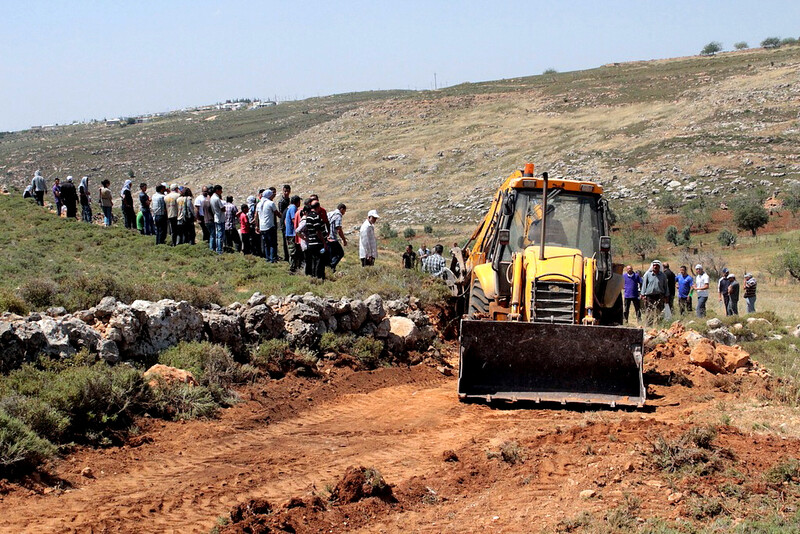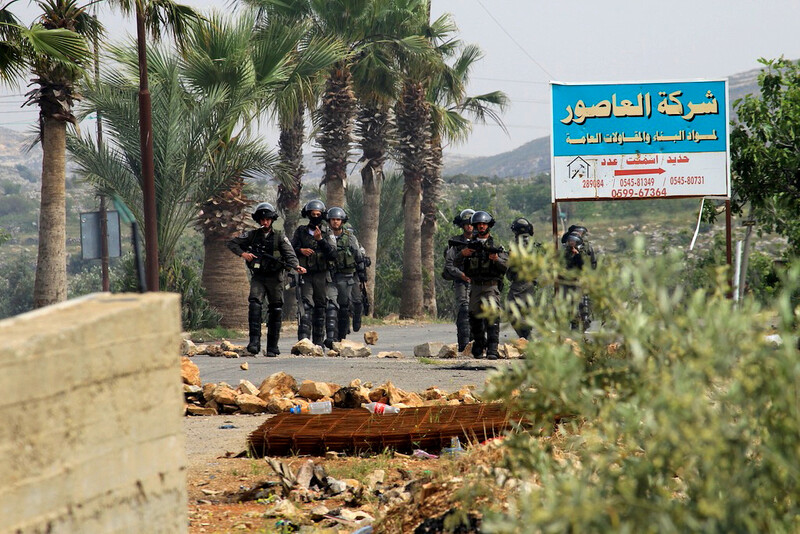The Electronic Intifada Deir Jarir 15 May 2013

Villagers use bulldozers to clear a path to access agricultural land in Deir Jarir.
Climbing the hill outside of Deir Jarir, it was easy to mistake the bulldozer’s purpose. In a village surrounded by settlements and an Israeli military base, construction equipment can conjure images of forced displacement and land theft, as this equipment is so often used for these purposes in Palestine.
But today, the bulldozers were driven not by Israeli occupation forces, but by Deir Jarir residents. And they were put to very different ends.
The fifth weekly demonstration was held on 10 May in the hills between the villages of Deir Jarir and Silwad, roughly 12 kilometers northeast of Ramallah. Demonstrators explained that the bulldozers were clearing a path for vehicles to reach the olive groves, making it easier for farmers to access their fields. The path would also provide an escape route for people running from soldiers and settlers when they inevitably attack the next demonstration.
Demonstrator and Deir Jarir resident Ibrahim Bakar said the demonstrations are a form of peaceful resistance against the expansion of the nearby Ofra settlement and its decade-old satellite, Amona.
“We’re here to prove that this land is ours. And we’re here to protect it, that’s all. We’re not here to attack anybody,” he said. “This our land. It’s been our land for the last 2,000 years.”
Almost two months ago, settlers from Amona tried to establish a new outpost in the hills between Deir Jarir and Silwad. They completed construction on one building before local youths burned it down, sparking “price tag” attacks from settlers, who burned ten cars in Deir Jarir, destroyed dozens of olive trees, and beat a 60-year-old man unconscious as he worked his field (“Violent settler attack in Silwad,” Stop the Wall, 11 April).
“Offensive” move
Bakar said the unarmed demonstrations are an “offensive” move, a show of strength and solidarity to stop the settler attacks.
“They’ve been more aggressive recently, so we felt like if we don’t stop them, if we don’t do this, there’s more to come,” he said. “So the only way to stop them is to be on the offensive, you know? Simple as that.”
Eid Khalil, the vice-president of Deir Jarir’s local council, said the residents decided to start holding weekly protests when they realized the settlers were determined to expand.
“They [the demonstrations] started about the settlers. From 1967 to 1970, they started to build settlements between Silwad and Deir Jarir,” he said. “We were surprised [that in] the last three to four weeks, they [left] the settlement to build another settlement … to extend it. And this is very dangerous for us, and causes us trouble. That’s why we’re protesting against it.”

The Israeli government steals water from Silwad and Deir Jarir for the settlements.
Besides the land theft and “price tag” attacks, the Israeli government takes most of the water from Deir Jarir and Silwad and gives it to the settlements, Khalil said.
“The water is here is from our land. But how much water do we get every week? Two days a week, ok? It’s not enough for you even to have a small plant around the house, not in the field. Water is a big, big problem for us. If you compare it with the settlers, maybe we have five percent of what they use,” he said.
Members of the Ecumenical Accompaniment Programme in Israel and Palestine, some of whom are living in villages near Deir Jarir and Silwad, have been monitoring the ongoing land theft and settler attacks.
EAPPI member Norman Williams said before the occupation began in 1967, Deir Jarir and Silwad had 33,000 dunams (8,154 acres) of land, 60 percent of which has been stolen for the illegal settlements of Ofra and Amona. The villages are now left with only 12,000 dunams (2,965 acres).
“They’re being compressed into a smaller and smaller area with no compensation and complaints not being answered by the civil authority,” he said. “So from a human rights perspective, we see that as very disappointing and very, very sad.”
The Israeli government considers Ofra to be a “legal” settlement, while Amona is considered an “illegal outpost.” But under international law, all settlements are illegal. Article 49 of the Fourth Geneva Convention states “The occupying power shall not deport or transfer parts of its own civilian population into the territory it occupies.”
Land theft
According to Shawan Jabarin, director of the Palestinian human rights organization Al-Haq, Israeli support for the settlements constitutes a breach of the Fourth Geneva Convention as well as the Rome Statute of the International Criminal Court. He said the settlements are part of an Israeli policy of systematic land theft from Palestinians.
“The occupation, it’s a temporary presence. And by transferring civilians, you try to make it permanent. That’s the issue. The nature of that, it’s like a colonialist nature,” Jabarin said. “Here in [the] Palestinian case, settlements have affected every aspect of Palestinians’ lives. The destruction of their property, the confiscation of their land, the expanding of Israeli jurisdiction over the settlements … the legal characterization is, it’s illegal apartheid.”
Since Silwad and Deir Jarir share much of the same farmland, they have held two joint protests together in the last month. Bakar said both villages plan to continue the demonstrations every Friday for the foreseeable future.
“We’re all in the same boat, because there’s no borders … some parts are from Silwad, some parts are from Deir Jarir. So there’s no difference, I think. … We’re in this together. And we’re all working toward the same goal,” he said.
Muhammad, a demonstrator who asked that his full name not be used, said the demonstrations are necessary to stop settlement expansion. If the people of Silwad and Deir Jarir do nothing, he said, the settlements will eventually overtake the villages.
“They are expanding their borders every year,” he said. “And if we still do nothing, they are going to reach the village. You see? They are coming.”
All photos by Andrew Beale.
Andrew Beale is an independent journalist from New Mexico. He reports on politics and social justice issues in the United States and Mexico as well as the Middle East.




